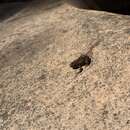Description
provided by AmphibiaWeb articles
Crinia riparia is a small frog species from southern Australia. Snout-vent length ranges 19.5-25.2mm. The dorsum is usually covered in fine warts, or is smooth. The snout is short and somewhat pointed. The tympanum is indistinct. Indistinct vocal sac in males. The digits are long and unwebbed, with fringes on the toes. Ventral surface varies in granularity, and may be entirely smooth. Females are larger than the males (Littlejohn and Martin 1965). C. riparia is distinguished from other Crinia species mainly by call, coloration, and larval morphology. The back pattern polymorphism seen in C. signifera and C. parinsignifera is incompletely expressed in C. riparia. C. riparia also has longer feet than either C. signifera or C. parinsignifera, and lacks a tarsal fold (Littlejohn and Martin 1965). Adult C. riparia are morphologically indistinguishable from adult C. flindersensis (Donnellan et al. 2012). Coloration in life: C. riparia are typically brown dorsally, and white or cream ventrally with black mottling. Throat grey in males, flesh colored in females. Color and pattern, however, are highly variable both dorsally and ventrally. Tadpole Morphology: C. riparia tadpoles have small streamlined bodies, which are wider than tall. They can reach a total length of up to 38mm with a minimum body length of 12.9mm (seen in a tadpole at stage 36). The nares open dorsally and have a small flap. The eyes are dorsolaterally located with golden irises. The tail is just over twice the length of the body. (Donnellan et al. 2012). C. riparia and its sister species C. flindersensis are mostly easily distinguished morphologically by their tadpoles. C. riparia tadpoles are less rounded in shape, have a less arched tail fin, a longer tail, and a wider oral disc which is more adapted to fast flowing water (Donnellan et al. 2012). The tadpoles metamorphose in spring (from October to December), with a snout-vent length of 9.7-11.4 mm. Their morphology and coloration is that of a miniature adult, with a translucent grey venter (Donnellan et al. 2012). Tadpole Coloration: C. riparia larvae range from golden brown (Horrock's Pass) to dark brown or black (Alligator Gorge) dorsally. The tadpoles have copper iridophores throughout the body, which increase in number as the larvae grows (Donnellan et al. 2012).The species authorities for C. riparia are M.J. Littlejohn and A.A. Martin. The original paper C. riparia by Littlejohn and Martin (1965) included specimens from the Northern Flinders Ranges as part of C. riparia. These are now identified as C. flindersensis, the Northern Flinders Ranges froglet, described in Donnellan et al. 2012. C. riparia is most closely related to C. flindersensis. Other related species include C. signifera and C. parinsignifera (Donnellan et al. 2012).
- Donnellan, S., Anstis, M., Price, L., and Wheaton, L. (2012). ''A new species of Crinia (Anura: Myobatrachidae) from the Flinders Ranges, South Australia.'' Zootaxa, 3499, 1-26.
- Littlejohn, M. J. and Martin, A. A. (1965). ''A new species of Crinia (Anura: Leptodactylidae) from South Australia.'' Copeia, 3, 319-324.
- author
- J.-M. Hero
- author
- L. Shoo
- author
- M. Stoneham
- author
- John Cavagnaro
Distribution and Habitat
provided by AmphibiaWeb articles
The species is found in the southern Flinders Ranges, between Mt. Brown Conservation Park in the north and Napperby Gorge in the south (Donnellan et al. 2012).
- author
- J.-M. Hero
- author
- L. Shoo
- author
- M. Stoneham
- author
- John Cavagnaro
Life History, Abundance, Activity, and Special Behaviors
provided by AmphibiaWeb articles
The call of C. riparia is a long, harsh, irregularly repeated note which can be described by the sound "kra-a-a-a-ack" (Littlejohn and Martin 1965). Adult C. riparia are found beneath boulders and stones on the edges of rock-strewn creeks. Spawn is laid beneath rocks at the edge of creeks (Barker et al. 1995). The streams inhabited by C. riparia end to have steeper slopes, faster moving water, and less vegetation than the habitats of other Crinia species. The tadpoles are benthic grazers and are adapted to fast moving water, with a flattened body, low fins, and wide oral disc (Donnellan et al. 2012).
- author
- J.-M. Hero
- author
- L. Shoo
- author
- M. Stoneham
- author
- John Cavagnaro
Life History, Abundance, Activity, and Special Behaviors
provided by AmphibiaWeb articles
No known declines.ThreatsNone known.Conservation MeasuresNone in place.
- author
- J.-M. Hero
- author
- L. Shoo
- author
- M. Stoneham
- author
- John Cavagnaro

